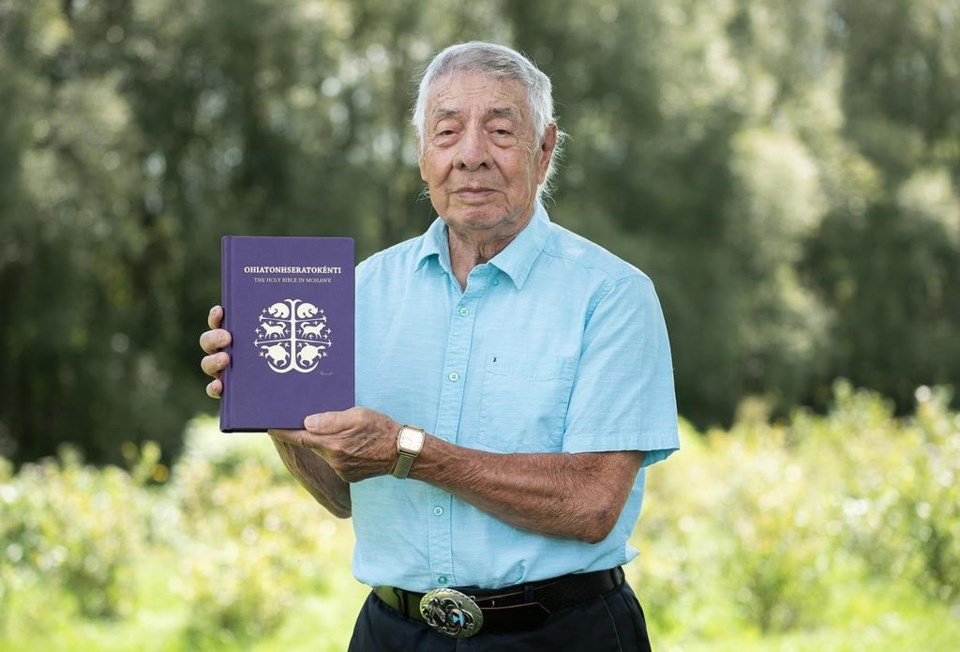KANESATAKE — Harvey Satewas Gabriel still remembers the first time he heard a preacher read Bible passages in the Mohawk language back in the 1950s. He watched the United Church minister open the book and translate the Scripture into Mohawk straight off the page as he read, the words sounding like “honey” to the then-17-year-old from Kanesatake, Que.
Gabriel went home and asked his mother why there was no Mohawk Bible. She said, "That’s a big project, who’s going to translate that?" he recalls.
That conversation would spark a decades-long passion that culminates this fall with the publication of a complete Mohawk-language Bible — most of it translated by Gabriel himself.
The 83-year-old estimates it took him about 17 years, on and off, to complete the translation, including 58 books he translated single-handedly.
Gabriel said that early conversation with his mother stuck with him. However, it wasn't until around 1980 that he first started translating Bible passages, when he was asked to give readings in Mohawk at his church, Kanesatake United.
The process became more formal in the 1990s, when he was invited to join a group of elders who gathered to translate Second Corinthians. While that group disbanded after a few years, Gabriel kept going on his own, working evenings and weekends prior to his retirement from a Montreal company in 2005.
“I kept going because when you start something for the Creator, you can't stop,” he said in a recent interview in the garden of his Kanesatake home. “It's so interesting. Every verse is different. I was wondering what the next verse says.”
The newly printed Bible has a purple cover — the colour of the Iroquois Confederacy flag — and an illustration depicting the turtle, wolf and bear clans. The title reads “Ohiatonhseratokénti" — a word Gabriel says means "holy pages."
When asked what motivated him, Gabriel’s answer is simple: “language.”
He was once told, and believes, that translating the word of God into his language means "it can never be lost." Already, he said, young people who are learning Mohawk have told him they are eager to use the Bible as a resource.
Gabriel, who has also written a Mohawk dictionary, is not the first member of his family to take language preservation to heart: his great-grandfather, Sosé Onasakenrat, translated the Four Gospels in the mid-1800s.
His mother, Gladys Jacobs, was a residential school survivor who managed to avoid losing her language by speaking it in the schoolyard with her sister and friends, he said. After that, she would only allow Mohawk to be spoken in her home.
Gabriel said that while he had no formal training, translating the Bible "wasn’t too difficult" because he is a fluent Mohawk speaker, and had his great-grandfather's translations as a model.
With funding from the Canadian Bible Society, he worked with several Biblical language professors to verify the accuracy of his work, translating his own words back into English for them to compare to the works in Hebrew.
According to Gabriel, one of the professors was astounded by the accuracy of the translation, telling him it was “side by side with the Hebrew.”
“That tells me my language is as old as Hebrew,” Gabriel said.
Gabriel said that eventually, funding for the project dried up, and his translation sat on shelves for a few years until his wife of 56 years, Susan, decided to make a renewed push to get it published.
Susan Gabriel connected with the United Church of Canada Foundation, who stepped in with funding to help with the final translation, proofreading, layout and printing.
Royal Orr, a board member for the foundation, said he believes the Mohawk Bible is one of only a handful of complete Indigenous-language Bible translations. The fact that Gabriel translated about 80 per cent of it himself — with support from his wife and others — is a sign of his "diligence, dedication and faith," as well as his remarkable artistry, he said.
"When you're translating the Bible, there's everything from legal texts to narrative to poetry to letters," Orr said in a phone interview. "It's all of these forms of writing."
A series of events will be held this fall to celebrate the publication, including a dedication at the Kanesatake United Church on Sept. 9 followed by celebrations in Montreal and Caledonia, Ont.
Gabriel said he will donate the proceeds of the sales of the Bible to Indigenous language organizations.
This report by The Canadian Press was first published Aug. 30, 2023.
Morgan Lowrie, The Canadian Press



